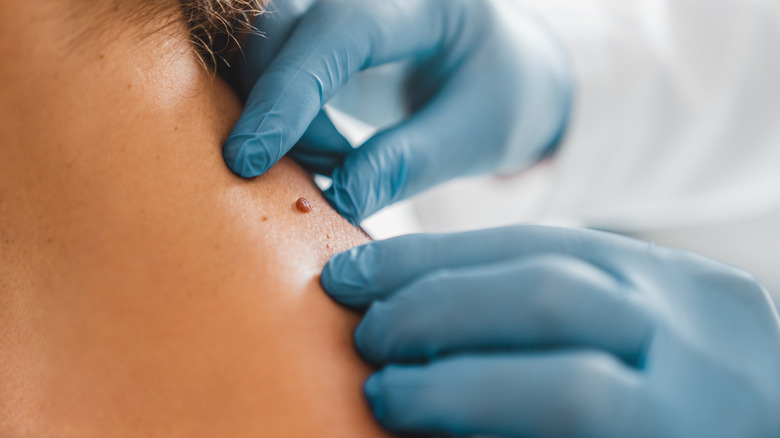Rachel Maddow's Cancer Diagnosis Explained
Rachel Maddow, a political commentator and host of her eponymous show on MSNBC, took to Twitter on October 6, writing, "Get your skin checked! Get on a schedule with your doctor. Schedule a check now, schedule the follow-ups. Do not blow it off." Maddow went on to explain that dermatologist appointments are easy and painless. In her tweet, Maddow also included a video from "The Rachel Maddow Show," in which she talked about how she was diagnosed with skin cancer.
Maddow revealed that she was sitting beside her longtime partner, Susan Mikula, at a baseball game when she pointed out a changing mole on her neck. Mikula advised her to ask her hairstylist and good friend, Diane, about it. When she did, Diane confirmed that she did indeed have a mole on her neck, and it had changed. This prompted Maddow to see a dermatologist, who performed a biopsy.
After the mole was found to be cancerous, doctors removed all of it during surgery and she now has "clear margins." Maddow took a few days off from work while she wore a bandage over the incision. After three days, she returned, feeling fine. Maddow says she'd like to be checked "like every five minutes" because she never wants skin cancer again.
Skin cancer explained
Rachel Maddow did not reveal which type of skin cancer she had, but there are four primary forms of skin cancer, melanoma, basal cell carcinoma, Merkel cell carcinoma, and squamous cell carcinoma, according to The Skin Cancer Foundation. The top two causes of skin cancer are exposure to ultraviolet tanning beds and ultraviolet rays from the sun.
Basal and squamous cell cancers are "most often found in areas exposed to the sun, such as the head, neck, and arms, but they also can occur elsewhere. They are very common but are also usually very treatable," according to the American Cancer Society. Merkel cell carcinoma is far rarer, and occurs when Merkel cells begin growing rapidly. Lastly, melanoma is caused by melanocytes, "the cells that give the skin its tan or brown color," grow uncontrollably, per the American Cancer Society. However, some melanomas can be white, pink, or tan. While melanoma is less common than basal cell and squamous cell skin cancers, it's much more dangerous if not caught early and treated. In addition, melanoma can spread to other parts of the body (via the American Cancer Society). The National Cancer Institute points out the risk factors for melanoma are fair skin, light eyes, blonde or red hair, and a family history of melanoma. Other risks are blistering sunburns, having moles, and exposure to UV rays.
You can get a free skin cancer screening from the American Academy of Dermatology Association, which has given nearly 3 million free cancer screenings and detected over 30,000 suspected melanomas. You can also see a dermatologist for a screening.


